Early 1830s
One of the first areas to develop on the Northshore was the area of Bernard Xavier de’Marigny de’ Mandeville’s sugar mill. The purchase of the property in 1830 was part of an English land grant. Some of the first lots for sale in Mandeville were offered in February of 1834 at a price of $80.00 per lot. The town of Mandeville was incorporated in 1840. The newly established town of Mandeville was located west of de’ Mandeville’s sugar plantation which is today a portion of the Fontainebleau State Park. Another adjacent area to the west of Mandeville is known as Lewisburg, founded in 1834.
1800s to early 1900s
In the mid 1800s and early 1900s as trees were harvested and milled, growth of the Mandeville area occurred as a result of the timber industry. On July 4, 1834, the first local hotel opened for business. The community began to attract attention as it became well known for the fresh smell of pine trees and its pure, healthy, ozone air, which was said to have natural healing qualities.
In 1837, steamboats from the New Orleans area began visiting St. Tammany Parish on the weekends and holidays. These steamboats were capable of ferrying 15 to 18 Model T type vehicles along with their passengers. When the excursion boats arrived, they would unload supplies and thousands of people seeking a weekend retreat in the Mandeville/Abita Springs communities. Visitors disembarked the steamships at wharfs along the Lake shore near Coffee Street and then travel to surrounding areas by electric or steam powered trains and trolleys. The population of Mandeville would often swell from a few hundred to several thousand on summer weekends and holidays. One of the largest gathering places in Mandeville was Jackson Park-an area extending from Coffee Street to Jefferson Street and Adair Street.
A New Orleans newspaper reported that a fire destroyed the Davis Hotel in Mandeville as early as 1847. The first attempts to offer some limited fire protection were in the late 1800s when the community fathers had cisterns bricked into the ditch bank in the old part of Mandeville. The runoff water from local artesian wells would accumulate in the ditches and then gather into the cisterns. In the unfortunate event of a fire, the cisterns could be used as a water supply for bucket brigades. Some of the cisterns were located at the intersections of Girod & Jefferson Street, Lafitte & Jefferson Street, Monroe & Girod Street, and Carroll at Claiborne Street. During this time there were two fire departments within the Mandeville town area-Fire Company No. 1 and Fire Company No. 2. One of the departments was noted as being very socially active. The department relied on family monies to fund their social events. The other company had very limited funds and proved to be a more ‘hands on’ organization when fires occurred. Fire Company No. 1 was chartered April 4, 1914. The first Fire Chief of record was Isadore Levy who served from an unspecified date through 1930.
1928
In May of 1928, a used 1917 Model T Ford Fire Truck was purchased from the City of Covington for local fire protection. It is believed that two citizens, Mr. Bossie and Theophile “Dad” Prudhomme acquired the Model T and also contributed money to build a Fire Station in the approximate location of 2118 Monroe Street (Fire Company No. 2). With the purchase of the hand crank Model T Fire Truck both departments merged into one department.
The 1917 Ford Model T was outfitted with two brass/ copper chemical tanks in which a soda acid solution could be mixed at the scene of a fire. The solution would produce pressure to propel a soda acid/foam mixture onto the fire. The mixture also produced a sticky, foam product that would extinguish the fire by smothering it. The 75 gallon tanks were utilized alternately on fire scenes. As one was deployed to extinguish the fire, the other tank was mixed and prepared for duty. The operator would cycle the tanks until the fire was brought under control. The engine was equipped with a rubber jacketed attack hose 200′ in length and 1″ in diameter.
The apparatus was housed behind Zachary Sharp’s Ford Dealership, Sharp Motors, in Mandeville located on Monroe Street near Lafitte. The building was designed and built expressly as a Fire Station for the Model T apparatus. The building still exists today (2007) at the approximate address of 2118 Monroe Street. While it is understood that department members met and drilled regularly with the small Model T Fire Truck, the apparatus never responded to a fire.
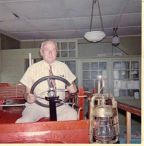
Mr. Zachary “Cutsie” Sharp in the show room of Sharp Motors. Mr. Sharp’s Logo was: “C♯ Sharp or B♭ Flat”.
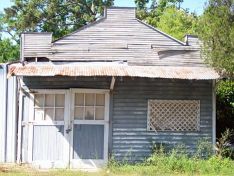
First Fire Station 2118 Monroe Street
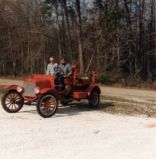
1917 Model T Fire Truck
Receiving and Dispatching Emergencies Throughout the Years
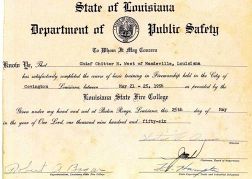
Training has always been an important part of the Fire Department’s History dating back to 1956. This is a certificate that was given to Chief Harold “Chitter” West, Sr. in May of 1956.
In the late 1800s and early 1900s the procedure for receiving and dispatching calls for the volunteer department was for someone to shoot a gun three times into the air as an alert to the firemen. Our Lady of the Lake Catholic Church located at 316 Lafitte Street, also provided assistance by ringing the Church bells when an incident was reported.
The first telephone exchange was opened in June of 1901 with 35 customers. The exchange was located on the west corner of the intersection of Jefferson Street and Carroll Street, 246 Carroll Street through the early 1950s. A person could now call the Bell Telephone switch board operator from the nearest, available hand crank telephone to report an incident. The telephone number for Sharp Motors was “50”. If unable to locate a telephone, the person reporting the incident could go to Sharp Motors or Mr. Sharp’s residence on Lafitte Street. Once notified, Mr. Sharp would activate a large siren mounted on top of a cypress water tower (approximately 45′ tall) to alert the volunteer fireman. The siren was a Sterling brand, 110-volt electric siren approximately 18″ tall by 30″ long. It had two large funnel ends to direct the sound away from the siren.
In the 1930s, Fire Chief Harold West, Sr. was the first to have a “combination” fire telephone and business telephone installed in his automotive repair garage. This was a single line telephone that would be activated from the telephone exchange manually by the Bell Operator. West’s garage, known as Chitter’s Garage, had the telephone number “67”. If no one answered the telephone, the Operator would refer to a written list of Fire Department members and call them at their place of work or call Sharp Motors to have the siren activated.
From the 1930s to 1961, a large siren was located at Sharp Motors. In 1961, the siren was relocated to the water tower at 1923 Jefferson Street for more sound effect. The siren’s last duty location was at 709 Girod Street from 1963 to mid 1971. If warranted and additional help was needed the siren would be activated to notify volunteer firemen. The volunteers would travel to the Fire Station and read a brief message written in chalk on a black board. The black board was posted on the exterior of the Fire Station. The written message would give the location and type of emergency. The black board system was used until July of 1971.
As time went on, a limited upgrade to the alarm system was added. From 1958 to the mid 1980s the reporting and receiving system for emergency was somewhat primitive. The reporting person would call the published telephone number in the telephone book to report a fire. From the early 1950s to the early 1970s, only four numbers were needed to be dialed, “3311”. The telephone number was connected to a ring-down-system. The system would activate ten telephones at one time. The caller would state his/her emergency and one of the volunteer firemen or his spouse would take down the information. The telephone ring-down-system was phased out in the mid 1980s. Most of the departments in the Parish and neighboring Parishes used the same receiving and reporting method at the time. While the system was quit primitive, it worked surprisingly well. An emergency call was never missed and the method somehow worked well for its time.
In July of 1971, the state-of-the-art Plectron Alarm System was activated. The department was the first to purchase a system to alert the volunteers on the Northshore. The complete alarm system including 22 receivers cost $5,500.00. The system utilized a Plectron Radio Receiver System about the size of a small shoe box. Most all of the volunteers had a receiver at their home or business. The system could be activated from the Girod Street Fire Station by an encoder using an alert tone and a verbal message. The radio equipment took the place of activating the siren to alert fireman.
By the early 1980s, the department again upgraded the alarm system. The receivers or pagers were small enough to be carried on volunteers’ belts. Volunteer membership ranged from 12 members to as many as 66 members in 1967. The volunteer membership remained around 50 into the mid 1980s.
Since the 1980s, the receiving and dispatch has been a various locations. While at 709 Girod Street, dispatch was manned by duty fireman. Next, the Fire District operated a state-of-the-art Fire Alarm Dispatch Center. The center was located at Station 43 on Highway 59 and was manned by a full dispatch staff. Then, dispatch service was contracted out through Fire District No. 1 in Slidell. Currently, the contract for dispatch service is with the Mandeville Police Department and will soon be relocated to the 911 Center in Covington for the Parish.
1930s
In the early to mid 1930s the town of Mandeville erected a water tower at 1923 Jefferson Street behind the Town Hall. During this time, the town of Mandeville installed 2″, 4″ and 6″ water lines throughout many areas within town limits. Fire hydrants were also installed at some street corners in the old Town area. Through a donation by Mrs. Galbert, the town of Mandeville received a hose cart, most likely with a hand powered water pump, to be used for fire suppression. Draft horses to pull the hose cart were provided by Ernest Prieto and Eugene Esquinance. Mr. Henry Rasch constructed a special harness that was used to connect the hose cart to the team of draft horses.
The horse drawn hose cart was replaced by a locally manufactured 4 wheel hose cart. The new cart was created by Harold West, Fire Chief and automotive garage owner. The 4 wheel hose cart was built on a Buick automotive chassis with two reels mounted on the cart. The cart was outfitted with 600 feet of 2″ fire hose and limited equipment. The cart was also designed to be pulled behind the Town dump truck.
When a fire occurred, gun shots, Church Bells, or the siren would be activated to alert department members. The members would then connect the hose cart to a team of draft horses or to the town’s dump truck. If the fire location was within range of a fire hydrant, the firemen would lay fire hose from the cart and limited assistance and suppression activities could occur. The Fire Hose Cart was located in a small two story building at Jefferson Street and Carroll Street on the North/East corner.
1945-1952
In 1945, an attempt to begin upgrading Fire Department equipment was undertaken by the town of Mandeville. A fund raising drive was started to allow for the purchase of a new Fire Apparatus with modern equipment. J. Clay Prieto was the Mayor of Mandeville and Harold West Sr. was the Fire Chief. Due to World War II, many items were in short supply as well as trucks and items made of brass and copper. The Fire Apparatus was not received until 1947. The 1947 Ford Fire Truck was outfitted with an 85 horsepower Flat Head V-8 gasoline engine, a 500 gallon booster tank, a Hale 500 G.P.M. mid-ship single stage fire pump and a large 6 volt spot light. The apparatus carried 1200 feet of 2″ hose and some 1″ hose. The Apparatus was produced by the Howe Fire Apparatus Company of Anderson, Indiana. The town of Mandeville with the financial assistance of many citizens thru fund drives, bingo’s, donations, etc. paid for the apparatus, hose and equipment.
From 1947 to 1950, the Fire Station was located at 2013 Jefferson. Then the Fire Station was moved to 1920 Madison Street next to the town jail. From 1950 to 1963, the apparatus was housed in a Town Storage Building/Fire Station at 1920 Madison Street with other town equipment. The 1947 Apparatus remained in service until the late 1970s.
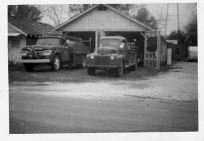
1952
In 1952, Southeast Louisiana Mental Hospital was opened just east of the town limits. In the early 1960s, the Hospital obtained a 1930s model Seagrave fire truck from State surplus in Baton Rouge, Louisiana. The truck was equipped with a V-12 gasoline engine, a mid-ship pump and hose bed. It was intended for fire protection at the mental institution. The Apparatus was replaced in the late 1960s with a Mini-Pumper mounted on an International chassis. The new mini pumper apparatus had a Hale brand 250 G.P.M. power-take-off mid-ship pump and was outfitted with a limited amount of hose and equipment.
Due to accreditation requirements for hospitals, the State Hospital put the fire apparatus in service. The vehicle was housed near the maintenance shop at the hospital. In the event of a fire or emergency, the maintenance department employees would operate the apparatus and extinguish the fire. While in service, the 1930s Seagrave fire apparatus and the Mini-Pumper had limited action. It is likely that they responded to less than five calls. Southeast Louisiana Hospital decommissioned the Mini-Pumper in the mid to late 1970s and installed a very elaborate alarm system throughout the facility for fire protection monitoring. The system is monitored around the clock at the Hospital’s Boiler Room and has direct links to the current dispatch center.
Funeral Bell
The large brass bell donated by Southeast Louisiana Mental Hospital is approximately 12″ at the base and 12″ tall and is used by the department for funerals. At one time, the bell was mounted on the front of the 1930s model Seagrave fire apparatus. Mr. Stemphfli, a volunteer, had the bell refinished and a bracket fashioned to store the bell. The bell is still used today for funerals.
1958
On January 16, 1958, the Fire District was formed by a joint resolution between the town of Mandeville and the St. Tammany Parish Police Jury. The Fire District was the fourth Fire District formed within the parish and was named St. Tammany Parish Fire Protect District No. 4. The newly formed Fire District was to be funded by a property tax mileage. The Property Tax election was held on February 26, 1958. At the time, both votes and Assessed Value of Property were needed for mileage votes. The results were 62 votes/value $124,650.00 “For” and 18 votes/value $28,450.00 “Against”. The two mil property tax generated an approximate budget of $5,000.00 the first year. The first citizens named to the Board of Commissioners were: (by Parish appointment) Rivers F. Galatas, Secretary/Treasurer and T.L. Doby, (by town of Mandeville appointment) Newell Frosch, Eugene Hannan, and Chairman Emory Esquinance.
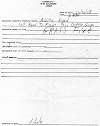
1959
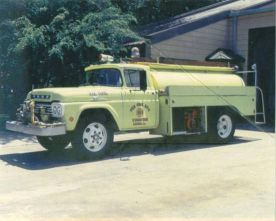
In 1959, the department again called upon Sharp Motors to assist the department with building a Fire Apparatus. The Department purchased a 1959 Ford F-600 chassis from Sharp Motors for $2,701.96, a portable pump $879.00, and, through the efforts of Father John Leblanc, O.S.B. of Our Lady of the Lake Church, a used 1,200 gallon fuel tank from St. Joseph’s Abby in Covington for $100.00. Through the combined efforts of the staff at Sharp Motors and many volunteer firemen, the homemade fire truck was painted red and outfitted with an extended front bumper to hold hose. The extended front bumper for hose was a first in 1959. The truck was ready for action within a few months. The approximate cost of the apparatus and fire fighting accessories was $6,000.00. The apparatus was housed at the Madison Street building until 1963 when the department moved to 709 Girod Street. In 1960, the portable pump was replaced with a 400 gallon per minute Barton-America front mount fire pump.
1961-1962
Initially, consideration was given to a parcel of property located at the south corner of the intersection of Marigny Avenue and Claiborne Street for the Fire District’s first Fire Station. The property was designated as a public parcel on the original town of Mandeville’s survey and would have been free to the department. However, following a review, the department decided the property would not be the best location due to its distance from Lake Pontchartrain, and that it was south of an active rail line, etc.
1962-1963
With the start of the Fire District in 1958 and a mileage based budget, the department had funds for growth. On March 22, 1962, the Board of Commissioners approved the $2,200.00 purchase of land from Preston Prieto to build a Fire Station on Girod Street. The property was in need of fill and debris removal. On Saturdays and Sundays, volunteers donated their time and used Police Jury equipment (dump truck, grader & shovels) to move dirt hills from Sharp Road and Lonesome Road to fill the property. Since volunteers donated their time, there was no additional charge for preparing the property.
Plans for the new Fire Station were drawn by William Berg, A.I.A. for $425.00. On June 22, 1962, the Fire Department awarded Gill Brothers of Mandeville the contract to build the Fire Station at 709 Girod Street for $9,318.95. The original building was 35′ by 50′ with three apparatus bays. The Fire Station was occupied on January 1, 1963. The total call volume was 31 calls per year.
1964
With the opening of the Greater New Orleans Expressway (the Causeway) in the late 1950s, the Mandeville area again experienced growth with new subdivisions and shopping centers being built. In 1964, the Fire District hired the first full-time fireman, Frank Mooney. Mooney, a retired New Orleans Fireman, only worked Monday through Friday during the day. In the late evening, nights, holidays, weekends, etc., the duty coverage was provided by local volunteer firemen. If a fire occurred during regular work day hours, the volunteers who operated businesses would close their businesses and go to the fire. Volunteers were business men from a variety of occupations-garage mechanics, barbers, clothing store owners, bar tenders, plant workers, etc.
1966
In 1966, the Fire District purchased it first custom built fire apparatus. The apparatus was built on a Ford C-750 chassis and the body was built by the Hahn Apparatus Company of Hamburg, Pennsylvania. The Apparatus was outfitted with a gasoline engine, standard transmission, a 750 G.P.M. mid-ship Hale brand 2-stage pump, and a 500 gallon booster tank. The apparatus completely equipped cost $25,000.00. During the early to mid 1960s, the three fire trucks were equipped with C.B. radios for communication purposes.
Today, the apparatus fleet consists of Fire Engines (Pumpers), a Heavy Rescue truck, a Ladder Truck, Ambulances, several utility vehicles, and a Hose Tender. The Hose Tender was the first of its kind on the Northshore and was outfitted with 2000’of 5″ supply fire hose.
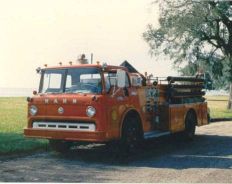
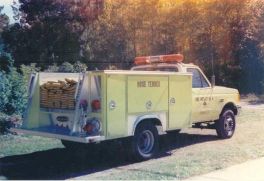
Late 1960s – Early 1970s
In the late 1960s, Riverwood and Covington Country Club subdivisions petitioned the Fire District to open a sub-Station to provide a quicker response to the area. The Fire District did not have available funds to operate a second Fire Station at the time. With the permission and support of Fire District No. 4 and limited funding from the Parish, a Fire Station was erected in the Riverwood Subdivision on Marilyn Drive. The subdivision volunteers acquired a used 1941 Fire Apparatus from the Michoud Assembly Facility in eastern New Orleans. The Fire Apparatus was built by the American LaFrance Fire Apparatus Company. The apparatus was mounted on a 1941 Ford chassis with a 500 G.P.M. mid-ship pump and a 300 gallon booster tank. A local contractor built the wooden two-bay Fire Station at no charge for the subdivision and district. Incidents responded by the sub-Station were limited in number. In 1974, the Walter Smith Memorial Fire Station located on Highway 22 was opened and the sub-station was closed.
In the late 1960s and early 1970s, Frank Stempfhli, a retired machinist, was appointed as the first dispatcher for the fire department. Mr. Stempfli lived near the Fire Station and had a fire telephone at his residence. When Stemphfli received a fire call he would proceed to the Station on Girod Street to monitor the telephone, radio messages, etc. Stempfli took the position very seriously and rarely missed a call. Stempfli also provided standby coverage of the fire station telephone when the volunteer department would conduct fire drills. During this time frame, the fire department was answering between 80 and 120 calls per year.
Early 1970s
In the early 1970s, Emile Jacobs was appointed as Chaplain to the Mandeville Volunteer Fire Department. For over 20 years, Jacobs began all meetings and drills with a pray. In 2004, Father John F. Talamo of Our Lady of the Lake Church was appointed as the department Chaplain.
1974
In 1974, the department developed a map book system to assist the volunteer and the employees with locating emergencies quickly. The map book system, a first for the Northshore, became a highly requested item by other service organizations such as the Mandeville Police department, the Sheriff’s Office, Ambulance providers, etc. In 1974, the original map book contained 29 zones. The map book system developed into a Demand Zone System which is now a standard for all emergency dispatched calls. The system is still in use today and now includes additional information such as fire hydrant locations. Today there are over 80 zones and the zones continues to grow with the community.
In November of 1974, the department changed the color of its apparatus from traditional red to the National Safety color lime-yellow. This was yet another first for the Northshore area.
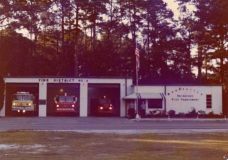
1975
In the early to mid 1970s, Interstate 12 opened bringing with it another rush of people into the area. As the community continued to grow, so did the department. In 1975, a second fire Station was opened-Walter Smith Memorial Fire Station on Highway 22. When the Station opened in 1975, the Station was only manned in the late afternoons/nights. This configuration continued for approximately four months until personnel could be trained and funding made available to man the Station on a continuous basis. Additional stations that were opened in the district include Station 43 on Highway 59 in February 1985 and Station 44 on Highway 190, East in 1987. These stations are manned continuously.
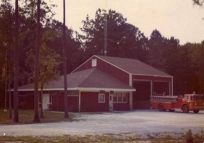
(3951 La. Hwy 22)
1976
In 1976, the operating budget for the Fire District was $65,430.00. The capital budget for improvements was $25,000.00. The total 1976 calendar year budget was $90,430.00. The emergency call volume was 297 calls.
1978
On June 25, 1978, through the efforts of a previous Fire Chief and Police Jury member, Edmond “Dutz” Baudot, a light Rescue/E.M.S. Unit was dedicated to service. The small van style rescue unit was equipped with an oxygen unit, hydraulic tools for extrication, additional suppression equipment, flood lights, radios, etc. The Light Rescue Unit and Equipment totaling $13,040.29 were donated to the department and remained in service until a larger rescue unit replaced it in 1984.
1983
On September 23, 1983, Fire Chief Leonard L. Frosch received a Fire Science Degree from Delgado Community College. Frosch was the first in the department to achieve a Fire Science degree.
1988
In 1988, the Fire District hired the department’s first full time Fire Chief, Chief Earl B. Gorrondona. He served as Chief from 1988 to 2004. In 1988, the department had 19 career firemen and 31 volunteers. The incident call volume was 626 calls.
1990
In August 1990, the Prieto Family offered a four acre site in the Pine Grove Industrial Park off Highway 59 area to the department for a Training Facility. In 1992, the drill tower became the first prop installed at the Training Facility. Since the land purchase in 1990, the department has funded development every year for improvement and training.
In December of 2006, the department purchased another 7.5 acres. The 11 acre Training Facility boasts a four story drill tower, several classrooms, a pond, L.P.G. props, C-PAT testing equipment, live fire and extrication stations, and ladder props. Additionally, four full-time Training Instructors conduct and facilitate daily/weekly training for current employees and neighboring departments.
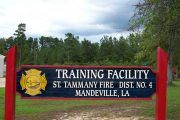
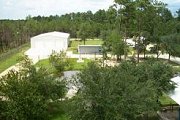
1994
In September of 1994, the department added one more first for the Northshore in the fire service sector. The department changed from a First Responder department to a full ALS Ambulance Service. This change reduced the need to wait for a private ambulance provider to arrive for transport. The ALS Service has grown from two ambulances to three with the availability to bring additional ambulances online within minutes. The fleet of five ambulances and a medical cart offer medical services to the citizens with a very quick response time (well below the national average) and timely delivery to any of the three local hospitals. The ALS Service accounts for an estimated 75% of the district’s call volume. The ALS service also provides protection to the line firefighters on fire scenes, hazardous material incidents, etc.
Mid 1990s
By the mid 1990s, the department went from a volunteer/career department to a full career department with pay and benefits.
1999
In 1999, the Fire District signed a contract to build an Administration Building next to the 709 Girod Street Fire Station. The Administration Building serves as the location for the offices of the Fire Chief, staff officers, and other support departments that include human resources, EMS billing, records, etc.
2002
The Property Insurance Agency of Louisiana (PIAL) issued Fire District No. 4 a Class 2 insurance rating on March 11, 2002. The PIAL classifications range from 10 to 1, with 10 being assigned risk, and 1 being most favorable and associated with the lowest fire insurance rate. Only a few departments in the state hold a class 1 or 2 rating.
2005-Hurricane Katrina & Hurricane Rita
The department resources and manpower were truly tested during Hurricanes Katrina and Rita in 2005. The men and women of Fire District No. 4 protected the area for 14 days and nights after Hurricane Katrina without relief. The first task following Katrina was to clear all major and secondary roads of trees and debris. The bravery and professionalism exhibited by department members during this tragic time have been the source of commendations both locally and statewide. Fontainebleau High School on Highway 59 was used as a command center for the fire department as well as other governmental agencies. During Hurricane Katrina Station 42 at 3951 Highway 22 and Station 44 at 24301 Highway 190 East sustained moderate damage from falling trees. Three weeks after Hurricane Katrina, Hurricane Rita struck the Louisiana coastline near Cameron. This storm put yet another strain on resources throughout Southern Louisiana.
Yesterday to Today
Much has changed in the department from the days of the Mandeville Fire Brigade of the mid 1800s when volunteers dipped buckets into the cisterns to extinguish fires. The department has blossomed into a department that is noted statewide for its accomplishments and in some instances for leading the way. In early 2006, the department boasted manpower of 97 employees with four Fire Stations and a full-time Training Facility responsible for training department personnel as well as neighboring department members. Being a full service department, Fire District 4 provides its citizens Fire Protection, EMS service, Hazardous Material service, Public Assistance, Fire and EMS educational opportunities, and many other related services. The department is expected to respond to over 5,000 calls this year.
The department continues to strive to be the “Best of the Best”. The department will continue to exhibit growth through increasing manpower and equipment, providing quality training, developing and refining skills, promoting educational opportunities, and pursuing innovative ideas. Members of this department know that they walk with the leaders of the Fire and EMS industries.
2008-50 Years of Proud Service
In 2008 Fire District No. 4 celebrated 50 years of dedicated service to the community and achieved another Class 2 rating
Past Fire Chiefs
Names of past Fire Chiefs and the years they served.
- Mandeville Volunteer Fire Department. (unknown date to 1958)
- Isadore Levy Unknown date to 1930
- Julius Levy 1930 to 1934
- Harold West Sr. 1934 to 1956
- Edmond Baudot 1956 to 1958
- St. Tammany Parish Fire Protection District No. 4 (1958 to date)
- Paul D. Esquinance Jr. 1958 to 1976
- Leonard L. Frosch 1976 to 1988
- Earl B. Gorrondona 1988 to 2004
- Merrick Tassin 2004 to 2016
- Kenneth Moore 2016 to Present

